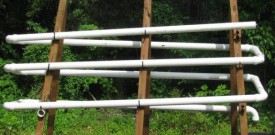(Nutrient film technique) SYSTEM
I can build this NFT SYSTEM
Nutrient film technique (NFT) is a hydroponic technique wherein a very shallow stream of water containing all the dissolved nutrients required for plant growth is recirculated past the bare roots of plants in a watertight gully, also known as a channel.
HERE’S WHAT YOU NEED TO GET STARTED
- (8) 8-ft 2×4’s
- (3) Sawhorse brackets
- (18) Curved metal plant hangers with screws
- (1) Drill and (1) 1.5” self-feed bit; you don’t want to drill a 2” hole or else the netcup might fall in. You may be able to use the Titanium Drill bit (HGDRBT); but we cannot guarantee it will go through a PVC pipe.
- (8) 3” PVC pipes that are 10 feet long
- (10) 3” PVC long sweep elbows
- (1) 3” PVC shorter sweep elbow
- (1) 3” End cap for PVC pipe
- ¼” Black Tubing (HGTB50 – about 6 feet)
- (1) 70 gal Active Aqua Premium White Reservoir with Cover (HGRES70K)
- (1) Active Aqua 550GPH Submersible Pump (AAPW550)
- (1) Active Aqua 10”-Pump Bag (AAPB10)
- (1) pack of 2” Netcup (HG2NETCUP)
If you want to grow your own plants, either 1.5” A-Ok Rockwool Plugs (RWAO3640) or Accelaroot Starter Plugs (JSAR50)
GH FloraGro (GH1423)
GH FloraMicro (GH1413)
SOS Beneficial Bacteria (STSOSPT)
HERE’S HOW YOU DO IT
- Fasten the 2×4’s to the sawhorse brackets so you have 3 sets.
- Dig holes where you want to place the legs of the A-frame. The sets of 2×4’s should be no more than 3.5’ apart from each other since the 2×4 going on top to keep them together is only 8 feet long . Bury the 3 sets of 2×4’s about a foot deep at an angle, so they meet to make the ‘A’. Place the top 2×4 in between the brackets. If you have extra 2×4’s it would be good to reinforce each set of A’s with some 2×4 in between. Now you should have a solid frame to work on.
- Screw in the metal plant hangers giving the PVC pipes a gradual incline as they go down to the reservoir (no more than a 2% gradient). You don’t want the water to be gushing down the pipes.
- Drill holes that allow the 2” Netcup to fall in without the cup falling in all the way through the hole. Somewhere around 1.5” diameter worked for me using a self-feed drill bit. It is best to experiment on a piece of PVC before you drill all your holes. Space the holes about 6” apart; you should be able to get around 120 holes on this system.
- Place the PVC pipes on the hangers. Cut PVC pipes for the end of the A-frames to connect to your main 10-ft pipes. Use the long sweep elbows to connect the PVC. You might get a good enough fit that it won’t leak. But if you need to, use some waterproof PVC glue to fasten the elbows to the pipes.
- Fasten the short sweep elbow to the end pipe going into the reservoir.
- Drill a ¼” hole in the end cap and cap the front of the first PVC pipe.
- Insert one end of the ¼” tubing into the end cap and connect the other end to the pump. Place pump in the pump bag. Make sure the tubing and pump cord are going through the port in the reservoir cover.
- Place the end PVC and elbow over the port of the reservoir cover so that water flows back into the reservoir. You can bury the reservoir if you want to avoid the heat of the summer. At surface level, I have been able to grow basil without any problems in the heat of the South. But other herbs don’t fare as well in the summer. I grow cool season greens and lettuce in the fall or early spring.
- Fill the reservoir with water and enough GH FloraGro and FloraMicro to bring the EC to between 1.0-1.5 for greens/herbs; adjust pH to around 6.0 if you need to. Plug in the pump and see that it’s all running smoothly. I also add some SOS Beneficial Bacteria at 5 ml/gal to help the reservoir stay clean.
This system works great for greens and herbs with small root systems; where the plant doesn’t get any bigger than a couple of feet. If you try to grow larger plants (like tomatoes) or ones with large root systems (like mint), then it will clog the 3” PVC pipes.
You can grow things like basil, lettuce, and small herbs directly in Grodan 1.5” A-Ok Plugs or Accelaroot Starter Plugs.
Or you can buy small transplants at the garden center and carefully wash off the soil. Just make sure there is enough of a root ball so that when you place it into the system, the roots are touching the bottom of the pvc.
Put the transplant into the Netcup and place it in the hole. If you need to give the transplant extra support, you can place a 2” Neoprene Insert in the cup to hold the plant (HGNEO2B).
Maintenance:
Run the system 24/7; that’s how NFT works.
Change the nutrients in the reservoir every 2-4 weeks. And keep an eye on pH and EC levels in between.
Remove any plants that are getting too old and possibly clogging the system with large root balls.
WARNING: If you use the whole system to grow basil, you will have enough pesto for the next couple of years in your freezer!
These Documents contain information gathered from many Online
Communities and all possible references have been given to the authors
of each individual article.



Comments
Post a Comment